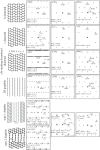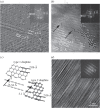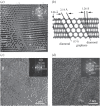Canyon Diablo lonsdaleite is a nanocomposite containing c/h stacking disordered diamond and diaphite
- PMID: 37691464
- PMCID: PMC10493553
- DOI: 10.1098/rsta.2022.0344
Canyon Diablo lonsdaleite is a nanocomposite containing c/h stacking disordered diamond and diaphite
Abstract
In 1967, a diamond polymorph was reported from hard, diamond-like grains of the Canyon Diablo iron meteorite and named lonsdaleite. This mineral was defined and identified by powder X-ray diffraction (XRD) features that were indexed with a hexagonal unit cell. Since 1967, several natural and synthetic diamond-like materials with XRD data matching lonsdaleite have been reported and the name lonsdaleite was used interchangeably with hexagonal diamond. Its hexagonal structure was speculated to lead to physical properties superior to cubic diamond, and as such has stimulated attempts to synthesize lonsdaleite. Despite numerous reports, several recent studies have provided alternative explanations for the XRD, transmission electron microscopy and Raman data used to identify lonsdaleite. Here, we show that lonsdaleite from the Canyon Diablo diamond-like grains are a nanocomposite material dominated by subnanometre-scale cubic/hexagonal stacking disordered diamond and diaphite domains. These nanostructured elements are intimately intergrown, giving rise to structural features erroneously associated with h diamond. Our data suggest that the diffuse scattering in XRD and the hexagonal features in transmission electron microscopy images reported from various natural and laboratory-prepared samples that were previously used for lonsdaleite identification, in fact arise from cubic/hexagonal stacking disordered diamond and diaphite domains. This article is part of the theme issue 'Exploring the length scales, timescales and chemistry of challenging materials (Part 2)'.
Keywords: diaphite; hexagonal diamond; lonsdaleite; nanocomposite; structural complexity.
Conflict of interest statement
We declare we have no competing interests.
Figures










References
-
- Bundy FP, Kasper JS. 1967. Hexagonal diamond- a new form of carbon. J. Chem. Phys. 46, 3437-3446. (10.1063/1.1841236) - DOI
-
- Cowan GR, Dunnington BW, Holtzman AH. 1968. Process for synthesizing diamond. US patent 3401019-A. See https://patents.google.com/patent/US3401019A/en.
-
- Frondel C, Marvin UB. 1967. Lonsdaleite, a hexagonal polymorph of diamond. Nature 214, 587-589. (10.1038/214587a0) - DOI
-
- Foote AE.1891 A new locality for meteoritic iron with a preliminary notice of the discovery of diamonds in iron. Am. J. Sci. S3–42 (251), 413–417. (10.2475/ajs.s3-42.251.413) - DOI
LinkOut - more resources
Full Text Sources

